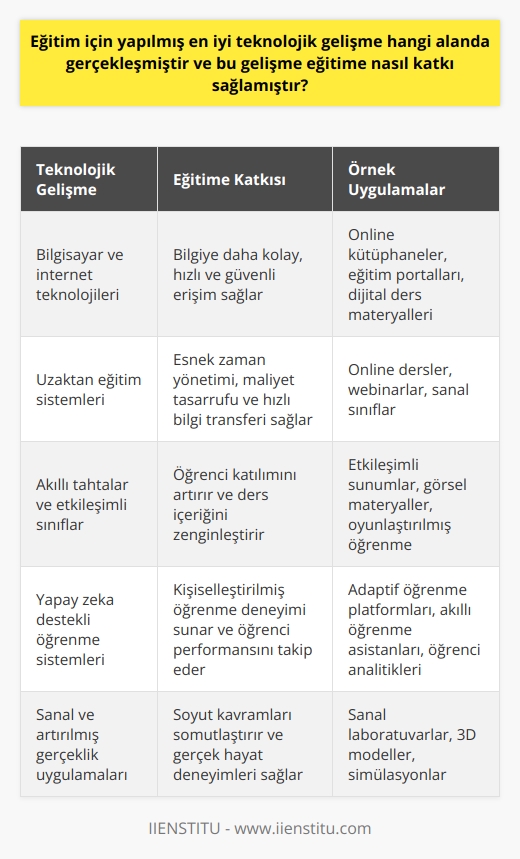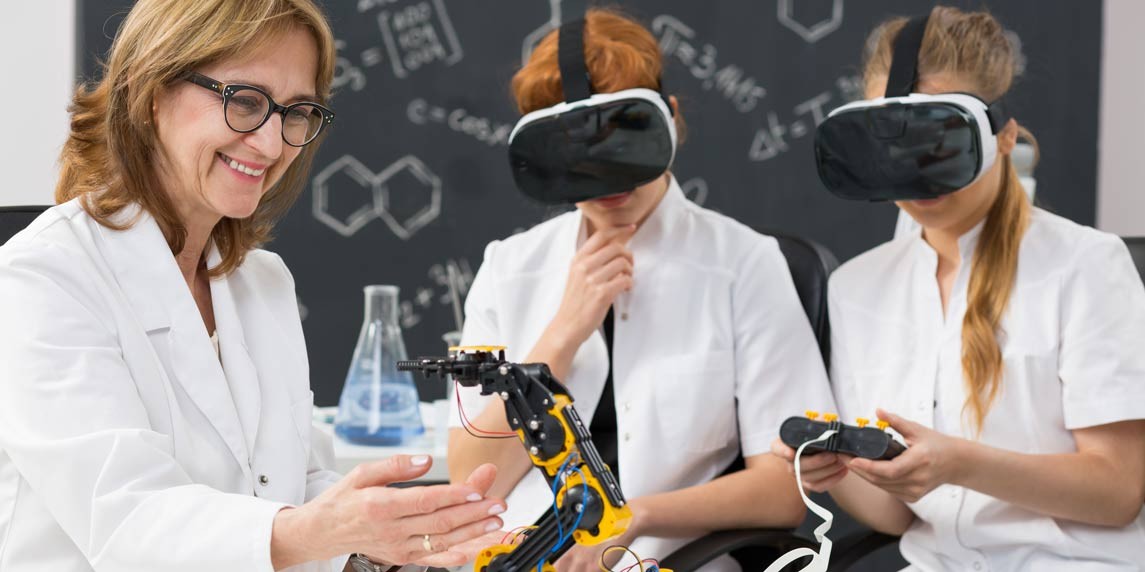
Education stands at the precipice of its most profound transformation in human history. The convergence of artificial intelligence, virtual reality, blockchain, and other emerging technologies is not merely digitizing traditional teaching methods but fundamentally reimagining what it means to learn, teach, and grow intellectually in the twenty-first century. As we advance through 2025 and beyond, the boundaries that once defined education—physical classrooms, rigid schedules, standardized curricula—are dissolving into a fluid, personalized, and infinitely accessible learning ecosystem that adapts to each individual learner's needs, preferences, and potential.
The magnitude of this transformation cannot be overstated. For centuries, education has followed essentially the same model: a teacher standing before a group of students, delivering information that students are expected to absorb and reproduce. This industrial-age approach, designed to produce workers for a predictable economy, is becoming obsolete in an era where the half-life of specific skills continues to shrink and the ability to learn continuously has become the most valuable competency. Technology is not just enhancing this old model; it is replacing it entirely with something far more powerful, flexible, and human-centered.
Consider the profound implications of artificial intelligence in education. No longer are we talking about simple chatbots or automated grading systems. Today's AI educational platforms can analyze millions of data points about how a student learns—their pace, their preferred modalities, their emotional states during different types of challenges, even their circadian rhythms and optimal learning times. These systems create dynamic, evolving profiles of each learner that are orders of magnitude more sophisticated than any human teacher could maintain for even a single student, let alone a classroom of thirty.
The Artificial Intelligence Revolution in Learning
The integration of artificial intelligence into education represents perhaps the most significant shift in pedagogical practice since the invention of writing. Modern AI systems are transforming every aspect of the educational experience, from curriculum design to assessment, from tutoring to administration. These systems don't just automate existing processes; they enable entirely new approaches to learning that were previously impossible.
When a student encounters a challenging mathematical concept today, AI-powered learning platforms can instantly diagnose not just that the student is struggling, but precisely why they are struggling. The system might recognize that the student has a gap in their understanding of fractions from three years ago that is now preventing them from grasping algebraic expressions. Within milliseconds, the AI can generate a personalized learning path that addresses this foundational gap while maintaining engagement with grade-level content. This level of granular, responsive instruction would require a team of expert tutors working around the clock with each student—something that AI now delivers at scale.
The sophistication of natural language processing has reached a point where AI tutors can engage in genuinely helpful dialogue with students. These systems understand context, detect emotional undertones, and adjust their communication style to match the student's needs. A frustrated student receives encouragement and simpler explanations, while an engaged student is challenged with deeper questions and connections to advanced topics. The AI remembers every interaction, building a comprehensive understanding of how each student thinks, what motivates them, and how they best absorb new information.
Predictive analytics powered by machine learning algorithms can now forecast with remarkable accuracy which students are at risk of falling behind, often weeks or months before traditional indicators would raise red flags. These systems analyze patterns invisible to human observers—subtle changes in assignment completion times, shifts in the types of errors made, variations in login patterns, or changes in peer interaction frequencies. When the system detects concerning patterns, it doesn't just alert teachers; it automatically adjusts the student's learning experience to provide additional support, alternative explanations, or motivational interventions tailored to that specific student's psychological profile.
The democratization of high-quality education through AI is particularly transformative for underserved communities. A student in a remote village can now access the same sophisticated AI tutor as a student in Silicon Valley. Language barriers dissolve as AI systems provide instruction in hundreds of languages and dialects, automatically translating and culturally adapting content. Students with learning disabilities receive accommodations automatically, without stigma or bureaucratic delays. The AI doesn't judge, doesn't lose patience, and is available twenty-four hours a day, seven days a week.
Virtual and Augmented Reality: Learning Through Experience
Virtual and augmented reality technologies are transforming abstract concepts into tangible experiences, making the impossible possible and the distant immediate. The impact of these immersive technologies on education extends far beyond novelty; they represent a fundamental shift in how humans can acquire knowledge and skills.
In medical education, virtual reality has already begun saving lives before students ever touch a real patient. Medical students can now perform hundreds of surgeries in virtual environments that perfectly replicate the look, feel, and even the resistance of human tissue. They can make mistakes without consequences, replay challenging procedures unlimited times, and experience rare medical conditions that they might never encounter during their training. The virtual operating room responds realistically to every action, teaching not just the mechanical steps of a procedure but also decision-making under pressure, team coordination, and crisis management.
History education has been revolutionized by virtual time travel. Students studying the American Civil War don't just read about Gettysburg; they stand on the battlefield, hear the cannon fire, and walk through the military camps. They can experience historical events from multiple perspectives—as a Union soldier, a Confederate general, an enslaved person seeking freedom, or a civilian caught in the conflict. This multiperspective immersion develops not just knowledge but empathy and critical thinking as students understand how the same events appeared radically different to different participants.
Science education through VR breaks the boundaries of scale and safety. Students can shrink down to explore the inside of a cell, watching proteins fold and DNA replicate in real-time. They can travel through the human bloodstream, observing white blood cells attacking pathogens. In physics, they can manipulate fundamental forces, seeing how changes in gravity or electromagnetic fields affect matter. Chemistry students can observe reactions at the molecular level, understanding not just what happens but why it happens. These experiences create intuitive understanding that no amount of textbook reading could achieve.
Augmented reality brings digital enhancements into the physical classroom, overlaying information and interactivity onto the real world. A student examining a mechanical engine through AR glasses sees labels for each component, watches animated demonstrations of how parts interact, and can access repair instructions or technical specifications instantly. Art students can see famous paintings come alive, with brushstrokes appearing in the order the artist painted them, while architectural students can walk through their 3D designs at full scale before a single brick is laid.
The social aspects of VR learning are equally transformative. Students from different continents can meet in virtual classrooms, collaborating on projects as if they were physically together. Language learning becomes immersive as students can instantly transport to virtual Paris, Tokyo, or Cairo, practicing with AI-powered native speakers in authentic cultural contexts. These experiences break down cultural barriers and develop global competencies essential for the twenty-first century.
Blockchain: Creating Trust and Portability in Education
Blockchain technology is solving one of education's most persistent challenges: the verification and portability of credentials. In a world where people change careers multiple times, pursue education from multiple institutions, and need to prove their qualifications across borders, the traditional paper diploma is woefully inadequate. Blockchain provides an immutable, instantly verifiable, globally accessible record of educational achievements.
The implications extend far beyond simple degree verification. Every course completed, every skill demonstrated, every project submitted can be recorded on the blockchain, creating a comprehensive, lifelong learning portfolio. Micro-credentials and digital badges stored on blockchain allow professionals to demonstrate specific competencies without needing to complete entire degree programs. An experienced programmer can earn a blockchain-verified credential in machine learning without returning to university for a full computer science degree. These credentials are immediately recognizable and valuable to employers worldwide.
Smart contracts on blockchain platforms are automating educational administration in ways that reduce costs and increase efficiency. When a student completes all requirements for a certification, the smart contract automatically issues the credential without human intervention. Payments for courses can be released to instructors automatically upon completion of specified milestones. Intellectual property rights for educational content can be managed transparently, ensuring creators are fairly compensated while making content widely accessible.
The technology is particularly transformative for refugees and displaced populations who often lose access to their educational records. With blockchain-based credentials, a refugee engineer can prove their qualifications instantly, anywhere in the world, without needing to contact institutions that may no longer exist or be accessible. This portability of credentials facilitates global mobility and ensures that human capital is not wasted due to bureaucratic barriers.
Educational institutions are beginning to form blockchain consortiums, creating interoperable systems where credits and credentials can transfer seamlessly between institutions. A student could take introductory courses from a community college, specialized courses from various online providers, and advanced seminars from a prestigious university, with all achievements recorded in a unified, verifiable transcript. This unbundling of education allows learners to customize their educational journey while maintaining the credibility and recognition of their achievements.
The Metaverse: Education Beyond Physical Boundaries
The metaverse is emerging as education's new frontier, offering possibilities that transcend the limitations of both physical and traditional digital learning environments. In these persistent, three-dimensional virtual worlds, education becomes an adventure rather than an obligation, a social experience rather than an isolated pursuit, and a creative expression rather than passive consumption.
Virtual campuses in the metaverse never close and have unlimited capacity. Students create avatars that represent them in these digital spaces, attending lectures in fantastical environments impossible in the physical world. A philosophy class might meet in a recreation of ancient Athens, a marine biology course might convene on the ocean floor, and an astronomy seminar might take place on the surface of Mars. These environments are not just backdrops but interactive learning spaces where the environment itself becomes a teaching tool.
The social dynamics of metaverse education address one of online learning's greatest weaknesses: isolation. Students form study groups in virtual libraries, engage in debates in digital amphitheaters, and collaborate on projects in shared virtual workshops. The casual interactions that are so valuable in physical education—the conversations before class, the impromptu discussions after lectures, the serendipitous meetings in hallways—are recreated and enhanced in the metaverse. Students from different time zones and cultures mingle naturally, creating a truly global educational community.
Gamification in the metaverse transforms learning into an engaging quest. Students earn experience points for completing assignments, unlock new areas of the virtual campus as they progress through their studies, and can display their achievements through their avatars' appearances or virtual possessions. Competition and collaboration are balanced through team challenges and individual achievements. This gamified approach taps into intrinsic motivation, making students want to learn rather than feeling obligated to learn.
The economic models of metaverse education are also revolutionary. Students can earn cryptocurrency or tokens for academic achievements, which can be used to purchase additional courses, virtual tutoring, or even real-world educational resources. Talented students can become paid tutors within the metaverse, creating a peer-to-peer learning economy. Educational content creators can sell their virtual learning experiences directly to students, bypassing traditional institutional gatekeepers.
Neurotechnology: Optimizing the Learning Brain
Neurotechnology is providing unprecedented insights into how the brain learns and offering tools to optimize cognitive performance. These technologies range from non-invasive monitoring systems that track brain activity during learning to more speculative future technologies that might directly enhance cognitive capabilities.
Electroencephalography (EEG) devices, now small enough to be integrated into comfortable headbands, can monitor students' brain waves in real-time during learning activities. These devices detect when a student is in an optimal learning state—alert but relaxed, focused but not stressed. When the system detects that attention is wandering or cognitive overload is occurring, it can automatically adjust the learning experience. The content might become more engaging, the pace might slow, or the system might suggest a break. This creates a responsive learning environment that adapts moment by moment to the student's cognitive state.
Neurofeedback training teaches students to recognize and control their own brain states. Through real-time visualization of their brain activity, students learn to enter and maintain states of focused attention, creative thinking, or calm reflection. This metacognitive awareness—understanding how their own mind works—becomes a powerful tool for lifelong learning. Students with ADHD have shown particular benefit from neurofeedback training, learning to manage their attention without medication.
Transcranial direct current stimulation (tDCS) and other brain stimulation techniques show promise for enhancing learning capacity. These technologies use very weak electrical currents to temporarily increase neuroplasticity—the brain's ability to form new connections. Early studies suggest that tDCS can improve mathematical learning, language acquisition, and memory formation. While still experimental and requiring careful ethical consideration, these technologies hint at a future where cognitive enhancement becomes a normal part of education.
The far frontier of neurotechnology—direct brain-computer interfaces—remains largely speculative but profoundly intriguing. Companies like Neuralink are developing implantable devices that could theoretically allow direct information transfer to the brain. While we are likely decades away from "downloading" knowledge like in science fiction, more modest applications are emerging. Brain-computer interfaces are already helping paralyzed individuals control computers with their thoughts, and similar technology could help students with severe learning disabilities interact with educational content in revolutionary ways.
Quantum Computing and 5G: The Infrastructure Revolution
The educational technologies of the future require computational power and network capabilities that are only now becoming available. Quantum computing and 5G/6G networks are not just incremental improvements but exponential leaps that enable entirely new educational possibilities.
Quantum computers can process certain types of problems millions of times faster than classical computers. In education, this translates to AI systems that can simultaneously optimize learning paths for millions of students, considering billions of variables in real-time. Complex simulations that would take classical computers years to run can be executed instantly, allowing students to explore sophisticated models of climate systems, economic markets, or biological processes interactively. The drug discovery simulations that pharmaceutical companies run on supercomputers could be available to high school chemistry students, letting them design and test molecular structures in real-time.
The pattern recognition capabilities of quantum computers will revolutionize educational assessment. Instead of simple right-or-wrong evaluations, quantum-powered systems can analyze the entire problem-solving process, understanding not just what students know but how they think. These systems can identify learning patterns across vast populations, discovering new cognitive types and learning styles that human educators never recognized.
5G and emerging 6G networks eliminate the latency that has limited remote education. With response times measured in single milliseconds, virtual reality becomes truly immersive, without the lag that causes motion sickness. Students can control robotic equipment in remote laboratories with precision that matches local operation. Holographic teachers appear without pixelation or delay. The massive bandwidth allows entire classes to engage in high-definition virtual experiences simultaneously without degradation.
Edge computing brings processing power closer to users, addressing both performance and privacy concerns. Instead of sending all student data to distant servers, edge devices can process sensitive information locally while still benefiting from cloud-based AI models. This distributed architecture ensures that educational technology remains responsive even in areas with limited internet connectivity, democratizing access to advanced educational tools.
The Transformation of Educational Institutions
Traditional educational institutions are undergoing radical transformation in response to these technological advances. The very concept of a school or university is being reimagined for the digital age. Physical campuses are becoming nodes in larger digital networks rather than self-contained educational universes.
Universities are unbundling their services, recognizing that different students need different combinations of content delivery, credentialing, mentoring, and social experiences. Some students might want only the knowledge, accessing course content without pursuing degrees. Others might need only the credential, demonstrating competency through assessment without attending classes. Still others value the social network and mentoring relationships more than formal instruction. Institutions are learning to serve these varied needs through flexible, technology-enabled models.
The role of teachers is evolving from information deliverer to learning facilitator, mentor, and coach. With AI handling content delivery and assessment, teachers can focus on what humans do best: inspiring, empathizing, and guiding. They become designers of learning experiences rather than lecturers, coaches rather than evaluators. This shift requires massive retraining of existing educators and fundamental changes to teacher education programs.
New types of educational institutions are emerging. Corporate universities are expanding beyond employee training to offer recognized credentials. Coding bootcamps and similar intensive programs are proving that valuable skills can be acquired in months rather than years. Online-first institutions designed from the ground up for digital delivery are outcompeting traditional universities that have merely digitized their existing processes. Decentralized autonomous organizations (DAOs) are experimenting with community-governed educational models where learners collectively own and operate their educational platforms.
Challenges and Ethical Considerations
The transformation of education through technology brings significant challenges that must be thoughtfully addressed. Digital inequality threatens to deepen existing educational disparities if not actively countered. While a wealthy student might have access to VR headsets, high-speed internet, and AI tutors, a disadvantaged student might lack even basic internet connectivity. Ensuring equitable access to educational technology requires substantial public investment and innovative approaches to technology distribution.
Privacy concerns become acute when educational systems collect vast amounts of data about students' learning patterns, emotional states, and cognitive capabilities. This data could be invaluable for improving education but could also be misused for discrimination or manipulation. Strong regulatory frameworks and ethical guidelines are essential to protect student privacy while enabling beneficial uses of educational data.
The risk of technology addiction and reduced human interaction must be carefully managed. While digital tools offer powerful educational capabilities, they cannot fully replace human connection and physical experience. Educational systems must balance digital and physical experiences, ensuring students develop social skills, physical fitness, and real-world competencies alongside digital literacy.
Algorithmic bias in AI educational systems could perpetuate or amplify existing educational inequalities. If AI systems are trained on data that reflects historical biases, they might provide better support to students who fit traditional success patterns while failing to recognize alternative forms of intelligence or cultural learning styles. Continuous auditing and adjustment of AI systems is necessary to ensure they serve all students fairly.
The authentication of human achievement becomes complex when AI can complete assignments and examinations. Educational assessment must evolve to focus on capabilities that remain uniquely human—creativity, critical thinking, ethical reasoning, and emotional intelligence. New forms of assessment that verify human authorship and understanding are being developed, but this remains an ongoing challenge.
The Path Forward: Recommendations for Stakeholders
Successfully navigating the transformation of education through technology requires coordinated action from multiple stakeholders. Educational institutions must embrace experimentation while maintaining quality standards. This means creating innovation labs where new technologies can be tested, establishing partnerships with technology companies, and fostering a culture of continuous adaptation among faculty and staff.
Educators need substantial support to adapt to their changing roles. Professional development programs must go beyond basic digital literacy to help teachers become learning experience designers, data interpreters, and technology integration specialists. Teachers should be empowered to experiment with new technologies while being protected from the pressure to adopt every new tool that emerges.
Students must develop new literacies for the digital age. Beyond traditional academic skills, they need digital literacy, data literacy, and the ability to learn continuously in rapidly changing environments. They must learn to be discriminating consumers of digital education, recognizing quality content and avoiding misinformation. Most importantly, they must develop the self-regulation skills necessary to thrive in self-directed digital learning environments.
Policymakers face the challenge of creating regulatory frameworks that protect students while enabling innovation. This includes privacy regulations that safeguard student data, accreditation systems that recognize new forms of credentialing, and funding models that support equitable access to educational technology. International cooperation is essential to ensure that educational credentials are portable across borders and that global standards emerge for quality in digital education.
Technology companies developing educational tools must prioritize pedagogical effectiveness over technological sophistication. The goal is not to use technology for its own sake but to genuinely improve learning outcomes. This requires close collaboration with educators, rigorous testing of educational impacts, and commitment to accessibility and equity.
Parents and families need support to understand and engage with their children's technology-enhanced education. This includes not just technical support but also guidance on balancing screen time, supporting digital learning at home, and recognizing signs of technology-related problems.
Conclusion: Embracing the Educational Revolution
The future of education technology represents humanity's best opportunity to democratize access to knowledge, personalize learning to individual needs, and prepare people for a rapidly changing world. The technologies described in this analysis are not distant dreams but emerging realities that are already beginning to transform education. The question is not whether these changes will occur but how quickly and equitably they will be implemented.
The transformation ahead is profound. Within a generation, the industrial model of education that has dominated for two centuries will be largely replaced by personalized, AI-driven, immersive learning experiences that adapt to each learner's needs, interests, and goals. Physical location will no longer determine educational opportunity. Economic circumstances will no longer limit access to the world's best teachers and resources. Learning disabilities will no longer be barriers to achievement but simply different paths requiring different support.
Yet technology alone is not the answer. The human elements of education—mentorship, inspiration, community, and growth—remain irreplaceable. The most successful educational futures will be those that harness technology to amplify human capabilities rather than replace human connections. Teachers empowered by AI will be more effective than either teachers or AI alone. Virtual experiences that complement rather than replace physical experiences will create richer learning than either could provide independently.
The pace of change will continue to accelerate. Technologies not yet invented will create educational possibilities we cannot currently imagine. The students of 2050 will learn in ways that would seem like magic to today's educators. But the fundamental goal remains constant: to help every human being reach their full potential, contribute to society, and live fulfilling lives.
As we stand at this inflection point in educational history, we have the opportunity and responsibility to shape a future where learning is lifelong, joyful, and transformative. The choices we make today about educational technology will determine whether future generations look back on this era as the moment when humanity finally made quality education truly universal or as a missed opportunity where technology deepened rather than dissolved educational inequalities.
The revolution in education technology is not coming—it is here. The question now is whether we will harness its power wisely, ensuring that the benefits of these remarkable technologies reach every learner, in every corner of the world, enabling them to build the future we can only begin to imagine.
Frequently Asked Questions
Ülkemizde Teknoloji Devrimi Ne Zamandı?
Ülkemiz de ilk olarak 1960 yılında tanıştığımız bilgisayar (IBM 650) şu an bize çok eski bir teknoloji olarak gelse de, o dönem için inanılmaz bir icat olarak tanımlanıyordu. Bilgisayarların gelişmesi ve 1993 yılında internetin hayatımıza girmesi ile ülkemizin teknoloji devrimi de başlamış oldu.
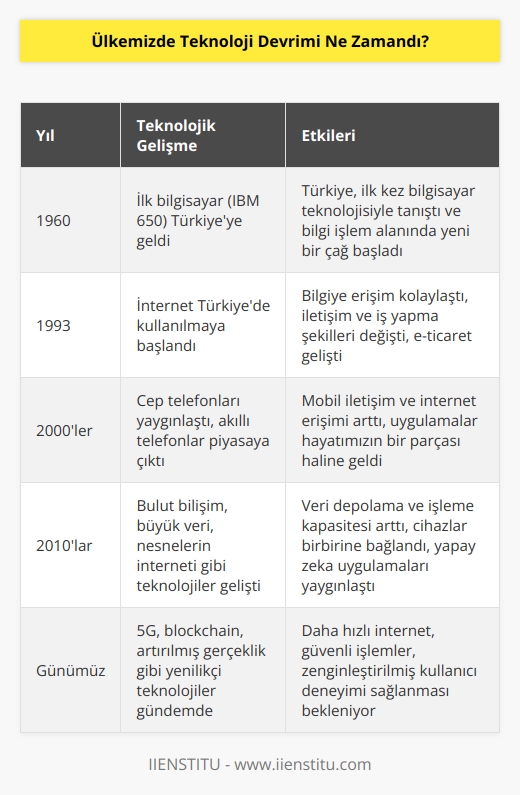
Bilgi Çağı ve Eğitim Arasındaki İlişki Nedir?
Eğitim sistemimizde kullanılan kara tahtalar, tepegözler, eğitim CD’leri gibi materyaller, yerini; akıllı tahtalara, bilgisayarlara ve internete bırakmış gibi görünse de eğitimcilerin geleneksel çözüm arayışları, uyguladıkları yöntem ve teknikler, teknolojinin imkânlarını yeterli kullanamaması, eğitim sistemimiz önündeki en büyük engel olarak durmaya devam ediyor.
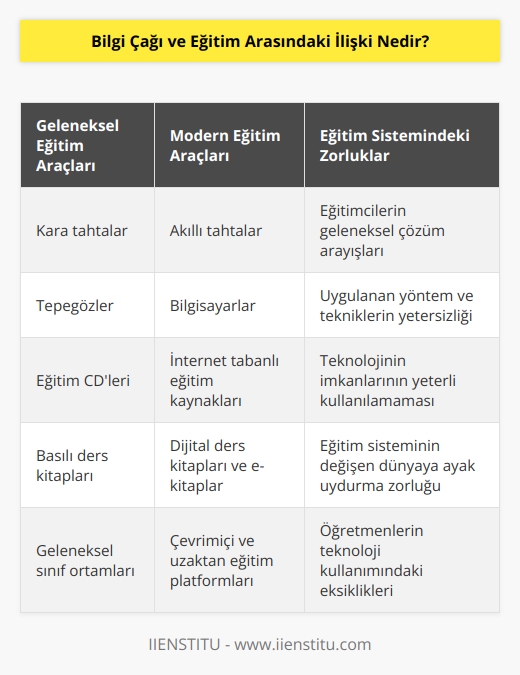
Kaliteli Eğitimin Temeli Nedir?
Teknoloji bize ne kadar eğitimin işlevlerini ve eğitim sürecini iyileştirmede yardımcı olsa da, kaliteli eğitimin temelinde öncelik her zaman kaliteli bireyler yetiştirmek olmalıdır.
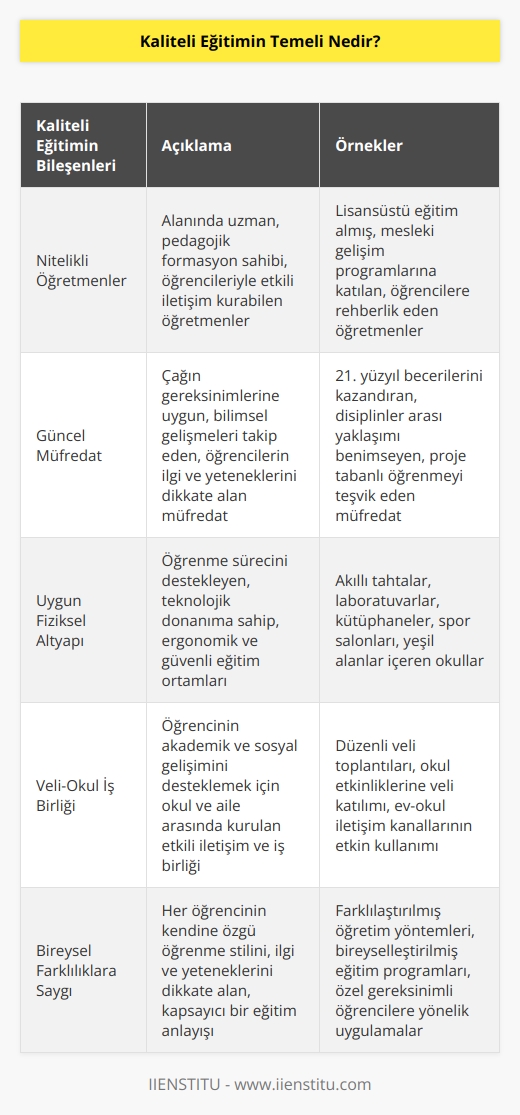
Gelecekteki Eğitim Teknolojileri Nasıl Olacak?
Gelecekteki eğitim teknolojileri, öğrencilerin daha iyi anlamalarını ve daha verimli öğrenmelerini sağlamayı amaçlayan çok yönlü bir yaklaşımı kapsayacak. Öğrenciler, çevrimiçi ortamlarda öğrenmeye dayalı deneyimler sunan sanal gerçeklik ve artırılmış gerçeklik teknolojilerinden faydalanabilecekler. Çeşitli öğrenme ortamları için gelişmiş öğrenme yönetim sistemleri, öğrencilerin öğrenimlerini kolaylaştıracak ve sınıf içi deneyimlerini artıracak. Teorik bilgiyi hayata geçirmek için öğrencilere daha fazla proje ve uygulamalı öğrenme imkanları sunulacak. Ayrıca, öğrencilerin öğrenimlerini desteklemek için kullanılabilir çoklu ortamlar ve dijital öğrenme araçları geliştirilecek.
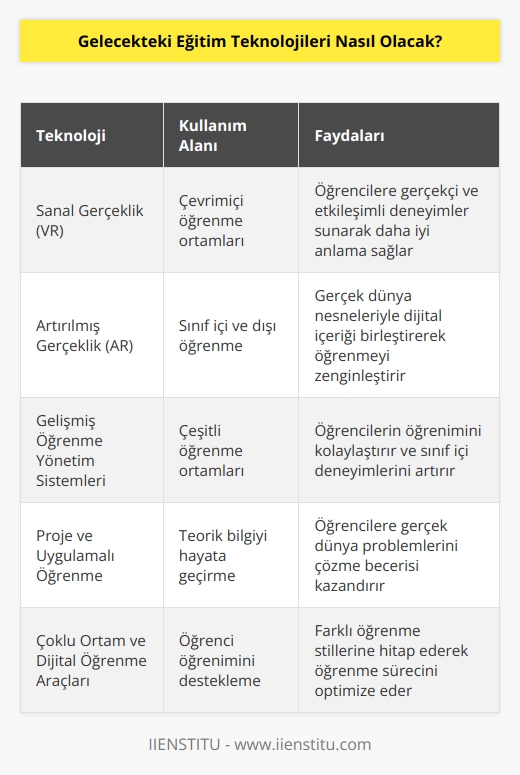
Teknolojinin Eğitime Katkısı Nasıl Olacak?
Teknolojinin eğitime katkısı, öğrencilerin öğrenme süreçlerini geliştirmek ve etkileşimli öğrenme ortamları oluşturmak için büyük bir potansiyel taşımaktadır. Teknoloji, öğrencileri öğrenmeyi kolaylaştıracak, öğretim sürecini etkileşimli hale getirecek ve öğreticilerin öğrencilerin öğrenme deneyimlerini kişiselleştirmelerini ve zenginleştirmelerini sağlayacak özelliklere sahiptir. Öğretim süreçlerinin etkileşimli olması, öğrencilerin öğrenmeyi daha verimli bir şekilde yönetmesine yardımcı olurken, öğrencilerin zihinsel becerilerini geliştirmelerine de yardımcı olur. Teknoloji, öğrencilere daha çok bilgiye erişim ve çoklu kaynaklara dayalı öğrenme deneyimleri sağlamak için kullanılabilir. Ayrıca, teknoloji sayesinde öğrenciler, kendi öğrenme ortamlarını kişiselleştirebilirler ve öğrenmeyi daha kolay ve keyifli hale getirebilirler.
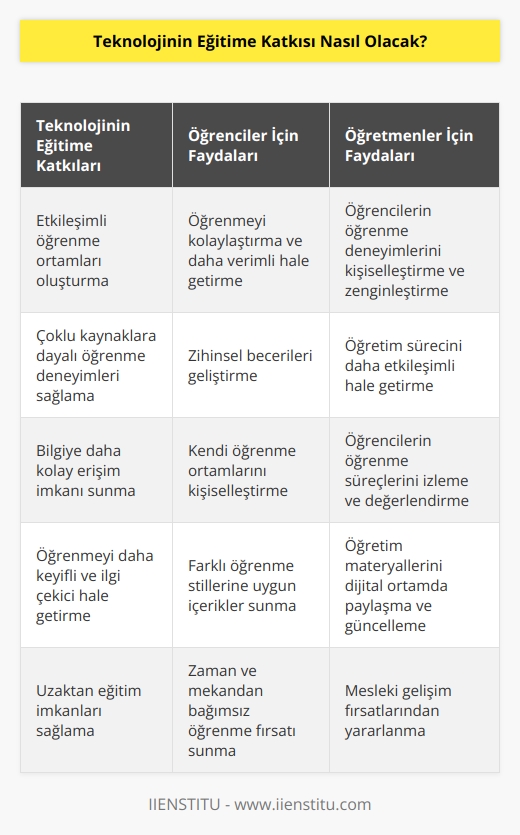
Eğitim Teknolojilerinin Kullanımı Nasıl Güvenli Hâle Getirilecek?
Güvenlik, eğitim teknolojilerinin kullanımını güvenli hâle getirmek için önemlidir. Buna uygun olarak, öğretmenler ve okul yöneticileri aşağıdaki önlemleri almalıdır:
Toplantılar ve eğitimler için güvenlik kurallarını belirlemek. Güvenlik kuralları eğitim teknolojilerinin güvenli kullanımı için çok önemlidir.
Öğrencilere, güvenlik politikalarını anlamaları, uygulamaları ve korumaları için eğitim vermek.
Güvenlik yazılımı kullanarak, bilgisayar sistemine ve verilere erişimin kısıtlanmasını sağlamak.
Sıkı parola politikalarının uygulanmasını sağlamak.
Kullanıcıların e-postalarını ve bağlantıları filtrelemek.
İnternet erişimini kısıtlamak ve özellikle kötü amaçlı sitelerden uzak tutmak.
İnternet güvenliğiyle ilgili olarak güncel tutmak.
Güvenlik eğitimleri vermek ve kullanıcıların bu konuda bilinçlenmesini sağlamak.
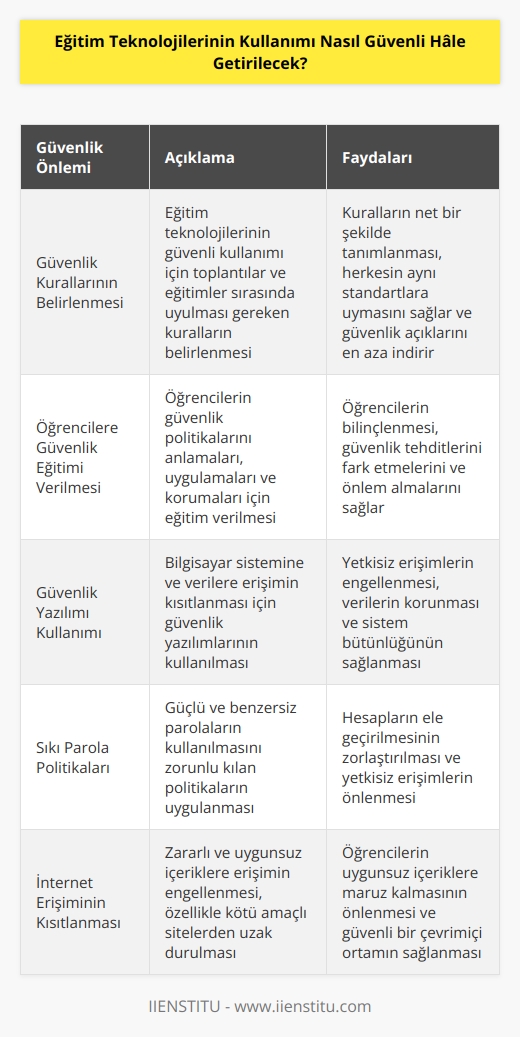
Gelecekte bizi bekleyen teknolojik gelişmeler, eğitim sistemi üzerinde ne tür etkiler yaratabilir ve bu değişiklikler eğitimin kalitesini nasıl etkileyecektir?
Gelecekteki Teknolojik Gelişmeler ve Eğitim Sistemine Etkileri
Gelecekte bizi bekleyen teknolojik gelişmeler, eğitim sistemi üzerinde önemli etkiler yaratabilir. Gelişen internet teknolojileri ve sanal gerçeklik uygulamaları sayesinde, insanlar bilgiye daha hızlı ve güvenli bir şekilde ulaşabilirken, eğitimin kalitesi de artabilecektir. Öğretmen ve öğrencilerin, yenilikçi pedagojik yöntemler kullanarak daha etkili ve verimli bir öğrenme deneyimi yaşamalarına olanak sağlayacak olan bu değişiklikler, eğitimin kalitesini de pozitif yönde etkileyecektir.
Teknolojinin İmkânlarının Yeterli Kullanımı
Ancak bu süreçte, eğitimcilerin geleneksel çözüm arayışları ve uyguladıkları yöntemlerin, teknolojinin imkânlarını yeterli kullanamayarak eğitim sistemimiz önündeki en büyük engel oluşturduğu da göz ardı edilmemelidir. Eğitim sistemi, bu gelişmeleri hızla entegre ederek, eğitimin kalitesinin artırılması için önemli adımlar atılmalıdır.
Uzaktan Eğitim ile Geniş Kitlelere Ulaşmak
Gelecekte, uzaktan eğitim veren üniversiteler ve eğitim öğretim kurumları, geniş kitlelere ulaşarak, birden fazla uzmanlık alanına sahip yeni nesiller yetişmesine büyük katkı sağlayacaklardır. Bu nedenle, teknolojiye uyum sağlama ve bu süreci hızlandırma becerisi, geleceğin eğitim sistemi için kritik öneme sahip olacaktır.
Hayal Edilen Teknolojilerin Gerçekleşmesi
Yakın gelecekte gerçekleşmesi muhtemel olan teknolojiler arasında sanal sınıflar ve hologram ile öğretmen ve öğrencilerin eş zamanlı olarak birden fazla derse katılabileceği düşünülmektedir. Aynı zamanda, sanal bellekler sayesinde hafıza sorunları ortadan kalkacak ve bilgiye ulaşmak için hiçbir araca ihtiyaç duyulmayacak bir eğitim sistemi oluşacaktır.
Geleceğin Eğitim Teknolojisi ve Kaliteli Eğitim İlişkisi
Tüm bunlar göz önünde bulundurulduğunda, geleceğin eğitim teknolojisinin eğitim anlayışımızı kökünden değiştireceği söylenebilir. Ancak, kaliteli eğitimin temelinde öncelikle kaliteli bireyler yetiştirmek olduğu unutulmamalıdır. Bu nedenle, teknolojik gelişmelere yaklaşım tarzımız ve eğitim sistemimizin sorunlarını doğru analiz etme yeteneğimiz, bu süreçte hayati önem taşıyacaktır. Eğer yeni teknolojik gelişmeleri yakından takip ederek, hem kendimizi hem de çocuklarımızı bu gelişmelere doğru şekilde adapte etmeyi başarabilirsek, eğitimin kalitesinin de önemli ölçüde artacağına şüphe yoktur.
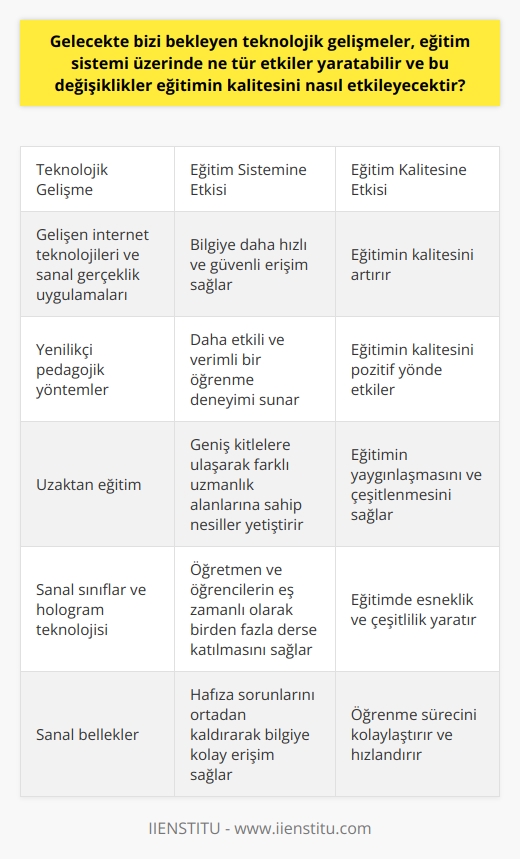
Eğitim teknolojileri kullanılarak öğrenci ve öğretmenlerin iletişimi nasıl daha verimli hale getirilebilir ve aynı zamanda öğrencilere bireysel öğrenme deneyimleri sunmayı nasıl başarabiliriz?
Eğitim Teknolojileri ve Verimli İletişim
Eğitim teknolojilerinin kullanımı, öğrenci ve öğretmenlerin iletişimi daha verimli hale getirmeye yardımcı olabilir ve öğrencilere bireysel öğrenme deneyimleri sunabilir. Öncelikle, teknolojinin sağladığı çeşitli eğitim materyalleri ve araçlar kullanılarak, öğretmenler öğrencilerle daha etkili ve etkileyici bir şekilde iletişim kurabilir. Bu da öğrenme sürecinde katılımı ve motivasyonu artırır. Ayrıca, eğitim teknolojileri sayesinde öğrencilere farklı öğrenme stillerine ve ihtiyaçlarına yönelik özelleştirilmiş materyaller sunulabilir.
Bireysel Öğrenme Deneyimi Sunumu
Bu süreçte, öğretmenler öğrencilerin ilgi alanlarına ve yeteneklerine göre daha fazla dikkat ederek, uygun eğitim materyallerini öğrencilere sunabilirler. Aynı zamanda, öğretmenler öğrencilerin öğrenme sürecini takip ederek, gelişimlerine uygun geri bildirimler ve destek mekanizmaları sağlayarak, öğrencilerin öğrenme deneyimini daha verimli hale getirebilir.
İnternet ve Eğitimde İşbirliği
İnternetin eğitim alanındaki yaygın kullanımı ile, öğrenciler ve öğretmenler arasında sınıf dışındaki iletişim de artmıştır. Bu durum, öğrencilere öğrencilerin öğrenme sürecine dair sorularını sorma ve geri bildirim alabilmelerine imkan tanır. Aynı şekilde, öğretmenler de öğrencilerden daha fazla geri bildirim alarak, eğitim süreçlerini sürekli geliştirebilir ve daha verimli hale getirebilir.
Eğitimde Yeni Nesil Teknolojiler
Günümüzde ve gelecekteki teknolojik gelişmeler sayesinde, eğitim süreçlerinde daha fazla verimlilik ve bireysel öğrenme deneyimi sağlanabilir. Özellikle sanal sınıflar, hologram teknolojisi ve sanal belleklerin eğitim alanında kullanılmasıyla, eğitim süreçlerinde daha geniş imkanlar ve daha öznel oyuncular sunulabilir.
Sonuç olarak, eğitim teknolojilerini kullanarak öğrenci ve öğretmenlerin iletişimini daha verimli hale getirmek ve öğrencilere bireysel öğrenme deneyimleri sunmak mümkündür. Bunun için önemli olan, teknolojik gelişmeleri yakından takip etmek ve eğitim süreçlerine uygun ve etkili bir şekilde entegre etmektir. Böylece, kaliteli bireyler yetiştirmeyi hedefleyen eğitim anlayışımızı daha da geliştirebiliriz.
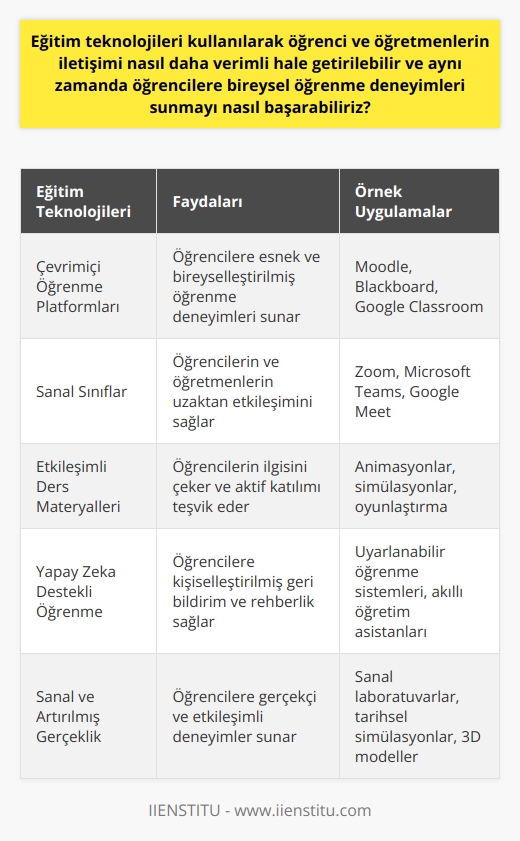
Eğitim teknolojisinin amaçları ve hedefleri nelerdir, bu amaçlara ulaşmak için hangi teknolojik araçların ve yöntemlerin kullanılması en uygun olacaktır?
Eğitim Teknolojisinin Amaçları ve Hedefleri
Eğitim teknolojisinin temel amaçları ve hedefleri, kaliteli öğrenme ortamlarının oluşturulması, bilgi ve beceri transferinin sağlanması ve öğrencilerin bireysel ve sosyal gelişimlerine katkı sunmaktır. Bu bağlamda, teknolojik araçlar ve yöntemlerin eğitim süreçlerine etkin bir şekilde entegre edilmesi büyük önem taşımaktadır.
En Uygun Teknolojik Araçlar ve Yöntemler
21. yüzyılda, eğitim alanında farklı teknolojik araçlar ve yöntemler kullanılabilir. Özellikle akıllı tahtalar, bilgisayarlar ve internet teknolojisi, eğitim materyallerinin daha etkili ve verimli kullanılmasına olanak sağlamaktadır. Ayrıca, sanal sınıflar, hologramlar ve sanal bellek teknolojileri gibi ileri düzey teknolojik gelişmeler de geleceğin eğitim sistemlerinin şekillenmesine etki edecektir.
Doğru Teknoloji Entegrasyonu
Kaliteli bir eğitim sistemi için teknoloji entegrasyonu doğru ve planlı bir şekilde gerçekleştirilmelidir. Eğitimciler, teknoloji kullanımı ile elde edilecek başarıları en yüksek düzeye çıkarmak amacıyla, teknolojinin sunduğu imkanları yeterli düzeyde kullanmalıdır.
Takip Edilmesi Gereken Teknolojik Gelişmeler
Geleceğin eğitim sistemi için, mevcut teknolojik gelişmelerin yanı sıra, önümüzdeki yıllarda gerçekleşebilecek yeniliklere de hazırlıklı olunmalıdır. Bu bağlamda, eğitim sistemimiz, yeni nesil teknolojilere uyum sağlama sürecini hızlı ve etkili bir şekilde gerçekleştirmelidir.
Sonuç olarak, eğitim teknolojisinin amaçları ve hedefleri doğrultusunda, en uygun teknolojik araçlar ve yöntemler kullanılmalı, eğitimciler teknoloji entegrasyonunu doğru bir şekilde yönetmeli ve teknolojik gelişmeler yakından takip edilerek kaliteli eğitim hedeflerine ulaşmak en temel öncelik olmalıdır.
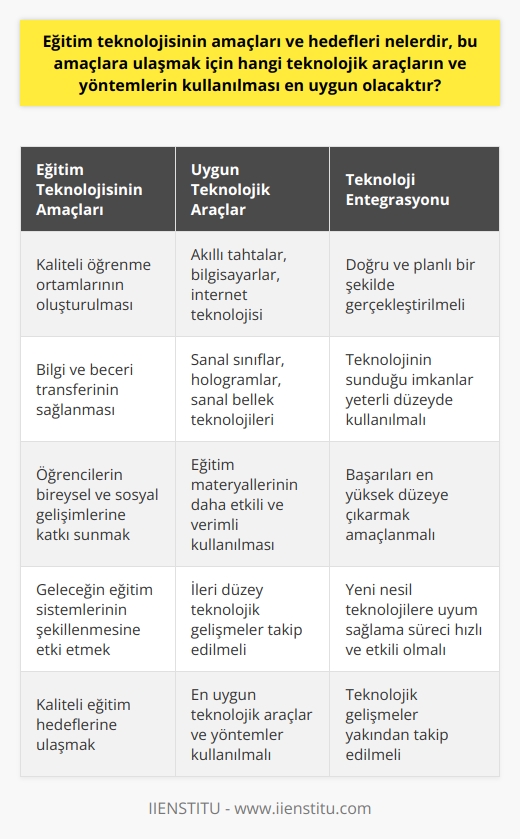
Gelecekteki Eğitim Teknolojileri Neler Olacak?
Gelecekteki eğitim teknolojileri, öğrencilerin öğrenme ve öğretme süreçlerinde daha verimli olmalarını sağlayacak çok sayıda yeni teknolojiyi içerecek. Öğrenciler, artan arama ve derin öğrenme teknolojilerinin kullanımıyla daha doğru ve anlamlı bilgilere ulaşabilecekler. Artan ölçeklendirilebilirlik ve ölçeklenebilir öğrenme teknolojileri, öğrencilerin öğrenme süreçlerini ölçeklenebilir kılabilecek. Ayrıca, e-öğrenme teknolojileri, öğretmenlerin ve öğrencilerin dışarıdan etkinlikleri takip etmelerini sağlayacak. Yeni teknolojiler, öğrencilerin daha fazla etkileşimli öğrenme deneyimleri yaşamalarını sağlayacak ve öğretmenlerin öğrencileri daha iyi yönetebilmelerini sağlayacak. Uzmanlar, dijital öğrenme ortamlarının, sanal gerçeklik ve artırılmış gerçeklik teknolojileri gibi gelişen teknolojileri kullanarak daha iyi bir öğrenme deneyimi sunacağını öngörmektedir.
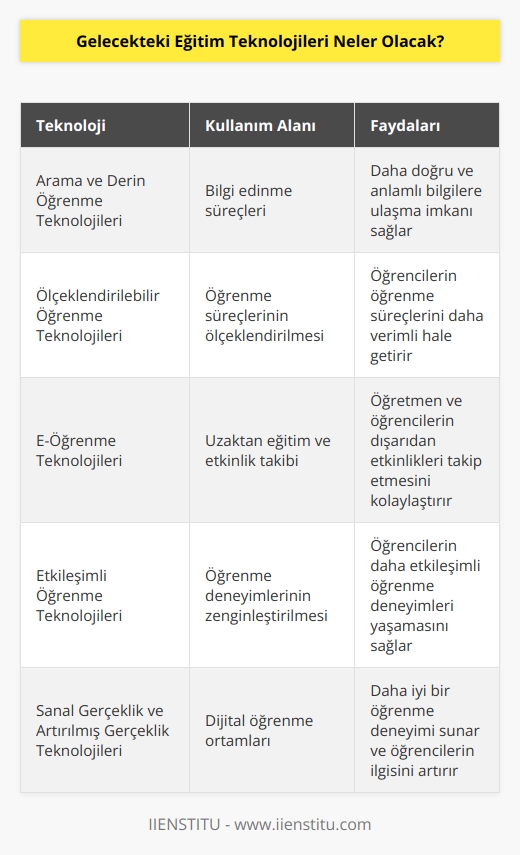
Eğitimin Teknolojiyle Nasıl Geliştirilebileceği Hakkında Ne Düşünüyorsunuz?
Teknoloji eğitimi geliştirmek için oldukça faydalı bir araçtır. Teknoloji, eğitimin daha verimli ve etkili olmasını sağlayarak öğrenmeyi kolaylaştırabilir. Öğretim teknolojileri, öğretimin kalitesini artırmanın ve öğrencinin öğrenme sürecini kolaylaştırmanın yollarını sunar. Teknoloji, öğretim yoluyla toplanan verileri izleme, analiz etme ve öğrencilerin öğrenme deneyimlerini geliştirme konusunda çok sayıda fırsat sunar. Teknoloji, öğretimin etkinliğini geliştirmek için birçok farklı öğrenme ortamlarını kullanmaya da izin verir. Örneğin, öğrenci uzaktan erişime sahip olduğunda, öğretimin kapsamını genişletme ve öğrencinin kendi özgürlüğünü artırma gibi fırsatları sunar. Ayrıca, öğrencilerin öğrenme ortamlarının özelleştirilmesine olanak sağlayan teknolojiler de mevcuttur. Özet olarak, teknoloji, eğitimi geliştirmek için çok önemli bir araçtır ve öğretimin etkinliğini artırmak için avantajlar sunar.

Teknolojinin Eğitime Ne Ölçüde Katkısı Olacak?
Teknoloji, eğitime çok büyük katkılar sağlayacaktır. Öğrencilerin, derslerinden daha fazla faydalanmalarını sağlamak için kullanılan çeşitli teknolojiler, eğitim sürecini daha verimli hale getirecektir. Örneğin, öğrencilere, kendi çalışma alanlarının dışındaki çoklu kaynaklardan bilgi edinme imkanı vermek için internetin kullanılması mümkün olacaktır. Ayrıca, öğrencilerin çoklu kaynaklardan bilgi edinmesine olanak tanıyan interaktif eğitim ortamlarının kullanılması da söz konusudur. Bu interaktif eğitim ortamları, öğrencilerin eğitim süreçlerini daha etkili hale getirmesine yardımcı olacaktır. teknolojinin eğitime katkıları, öğrencilerin daha kolay ve hızlı öğrenmesini sağlayacaktır.

Geleceğin teknolojisi neler olabilir ve bu teknolojiler eğitime nasıl entegre edilebilir?
Öngörüler ve Beklentiler
Gelecekteki teknolojilerin neler olabileceğini öngörmek zor olsa da, yapay zeka, nesnelerin interneti, sanal gerçeklik ve artırılmış gerçeklik gibi alanlarda yaşanan hızlı ilerlemeler sayesinde bazı tahminlerde bulunabiliriz. Bu teknolojilerin eğitime entegrasyonu, öğrenme sürecini daha verimli ve etkileşimli hale getirebilir.
Yapay Zeka Uygulamaları
Yapay zeka, gelecekte eğitim sektöründe önemli bir rol oynayabilir. Öğrencilere bireysel öğrenme deneyimleri sunan akıllı öğretim sistemleri, öğrencilerin anlama seviyelerine ve hızlarına uygun olarak müfredatı uyarlayabilir. Ayrıca, yapay zeka tabanlı yardımcılar öğretmenleri destekleyerek, dikkatlerini öğrencilerin yaratıcı ve eleştirel düşünme becerilerini geliştirmeye yönlendirebilir.
Nesnelerin İnterneti Eğitimde
, okul ve öğrenme ortamlarını dönüştürmede büyük potansiyele sahiptir. Gelecekte, ile donatılmış sınıflar öğrencilere daha interaktif ve deneyimsel öğrenme fırsatları sunabilir. Ayrıca, okullarda enerji ve kaynak kullanımı daha verimli ve sürdürülebilir hale gelebilir.
Sanal Gerçeklik ve Artırılmış Gerçeklik
Sanal gerçeklik ve artırılmış gerçeklik teknolojileri, eğitimde devrim yaratabilir. Öğrenciler, tarihi olayları, coğrafi bölgeleri ve hatta molekül yapısını gözlemlemek gibi konuları daha derinlemesine inceleyip yaşayarak öğrenebilir. Bu, öğrencilerin öğrenme sürecine daha fazla katılmasını ve anlamalarını artırabilir.
Eğitim-Yenilik İçin İşbirliği
Elbette, gelecekteki teknolojilerin eğitime entegrasyonu, eğitimciler, teknoloji üreticileri ve politikacılar arasında sıkı işbirliğini gerektirir. Bu işbirlikleri, teknoloji tabanlı eğitim uygulamalarının, eğitim sistemi ihtiyaçlarını ve öğrencilerin hedeflerini karşılayacak şekilde geliştirilmesini sağlamalıdır.
Sonuç olarak, geleceğin teknolojisi, eğitimi dönüştürme ve her öğrenciye uygun, etkileşimli ve deneyimsel öğrenme fırsatları sunma potansiyeline sahiptir. Bu dönüşümün gerçekleşmesi, eğitim ve teknoloji sektörlerinin ortak çabalarıyla mümkün olacaktır.
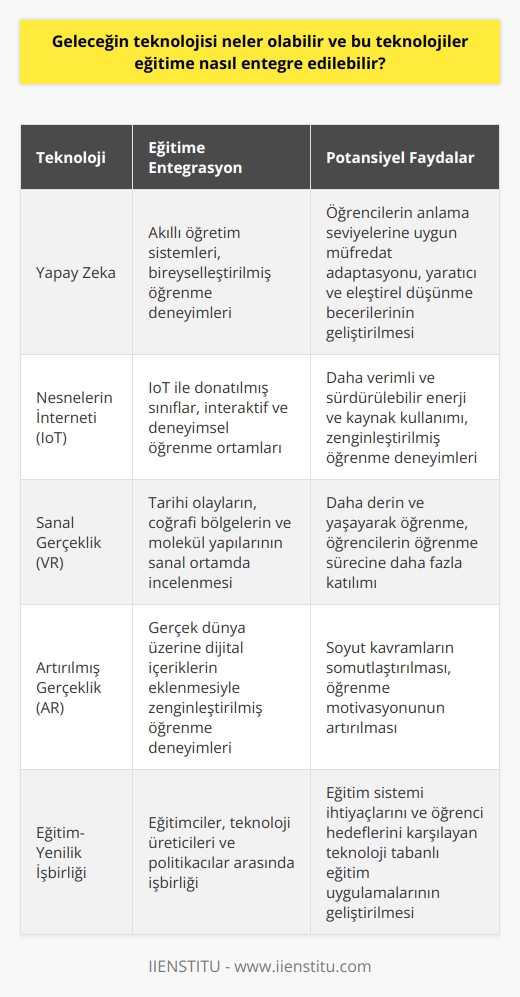
Eğitim Teknolojisi kapsamında hangi yöntemlerle öğrenci ve öğretmenlerin eğitim süreci optimize edilebilir ve bu sürece nasıl adapte olunmalıdır?
Eğitim teknolojisi kullanımının yaygınlaşmasıyla, öğrenci ve öğretmenlerin eğitim süreçlerini optimize etmek için çeşitli yöntemler uygulanabilir. Bu süreçte dikkate alınması gereken temel yöntemler; öğrenci merkezli öğrenme, takım çalışması ve teknolojinin entegrasyonudur.
Öğrenci Merkezli Öğrenme
Eğitim süreçlerinin optimize edilebilmesi için öğrenci merkezli öğrenme modellerinden yararlanılabilir. Öğrencilerin bireysel farklılıklarına, tercihlerine ve yeteneklerine uygun öğrenme kaynakları sunarak, öğrencilerin daha etkili ve verimli şekilde öğrenmeleri sağlanabilir. Öğretmenler, yaparak ve yaşayarak öğrenme prensiplerini kullanarak öğrencilere daha ilgi çekici ve pratik eğitim deneyimleri sunmalıdır.
Takım Çalışması
Öğrenci ve öğretmenlerin eğitim sürecini optimize etmek için takım çalışmasına önem verilmelidir. Öğrencilerin grup projeleri ve atölye çalışmaları ile birlikte hareket ederek, daha iyi iletişim ve problem çözme becerileri kazanmalarına olanak sağlanmalıdır. Ayrıca, öğretmenler de kendi mesleklerindeki gelişmeleri takip etmek ve yeni yöntemler öğrenmek için sürekli eğitime tabi tutulmalıdır.
Teknolojinin Entegrasyonu
Eğitim teknolojileri araştırma ve uygulamalarının sonucunda ortaya çıkan etkili ve yenilikçi yöntemler kullanılarak eğitim süreçleri optimize edilebilir. Öğrencilere farklı medya ve modüller ile öğrenme fırsatları sunarak, öğrenci katılımını ve ilgisini artırılabilir. Öğretmenler ise, teknolojik araçları kullanarak konu anlatımını, öğrenci değerlendirmelerini ve geribildirimleri daha efektif hale getirebilirler.
Eğitim Sürecine Adaptasyon
Öğrenci ve öğretmenlerin, eğitim teknolojileri ve yenilikçi yöntemlerle desteklenmiş eğitim süreçlerine adapte olabilmeleri için, başlangıç aşamasında eğitim ve destek sağlanmalıdır. Öğretmenlerin teknoloji kullanımı ve yenilikçi öğrenme yöntemlerine yönelik eğitim almaları teşvik edilmeli ve okul yönetimleri tarafından desteklenmelidir. Ayrıca, öğrencilere de düzenli olarak bilgilendirme ve eğitim faaliyetleri sunarak bu sürece daha rahat uyum sağlamaları amaçlanmalıdır.
Sonuç olarak, eğitim süreçlerini optimize etmek amacıyla eğitim teknolojisi kapsamında öğrenci merkezli öğrenme, takım çalışması ve teknolojinin entegrasyonu gibi yöntemler kullanılarak hem öğrenci hem de öğretmenlerin bu sürece adapte olmaları sağlanabilir. Öğretmenlerin ve öğrencilerin bu sürece hazırlanmaları için ise eğitim ve destek faaliyetlerine önem verilmelidir.
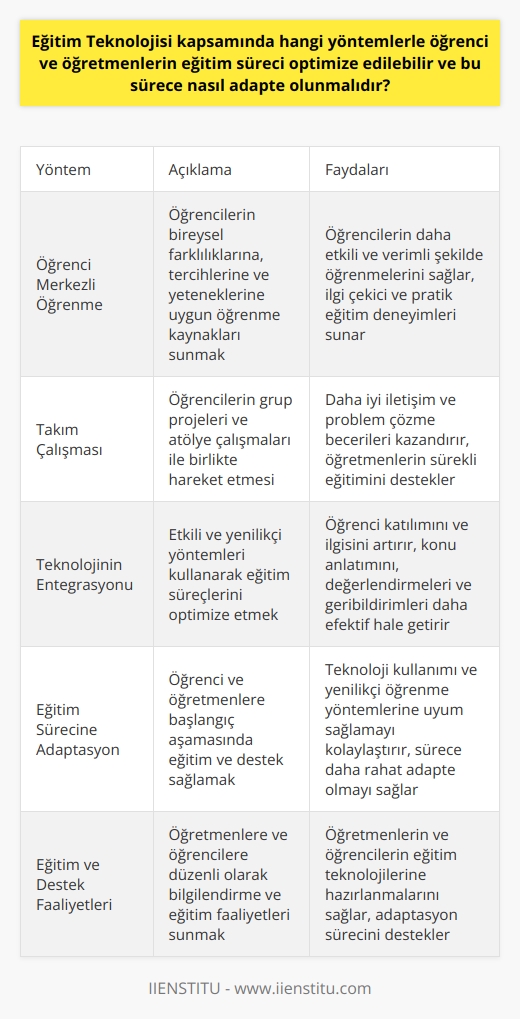
Eğitim teknolojisinin temel amacı nedir ve bu amaç doğrultusunda geliştirilen teknolojik araçlar eğitime nasıl katkıda bulunmaktadır?
Eğitim Teknolojisinin Temel Amacı
Eğitim teknolojisinin temel amacı, eğitim ve öğretim süreçlerini daha etkili, verimli ve yenilikçi hale getirmektir. Bu amaç doğrultusunda geliştirilen teknolojik araçlar, eğitime önemli ölçüde katkıda bulunmaktadır.
Araçların Eğitime Katkısı: Öğrenci Motivasyonu
Eğitim teknolojisi araçları, öğrencilerin dikkatini çekme ve motivasyonunu artırma açısından önemlidir. İnteraktif uygulamalar, videolar ve oyunlar sayesinde, öğrenme süreci daha eğlenceli ve ilgi çekici hale gelmekte ve bu durum öğrencilerin başarı oranını artırmaktadır.
Öğrenme ve Öğretme Stratejileri: Bireyselleştirme
Teknolojik araçlar, öğrencilere daha bireyselleştirilmiş öğrenme ve öğretme deneyimleri sunarak, onların öğrenme stillerine ve düzeylerine uygun materiyaller sağlamaktadır. Bu durum, hem öğrencilerin hem de öğretmenlerin, öğrenme sürecine daha etkili bir şekilde katılmalarına olanak tanımaktadır.
Değerlendirme ve Geri Bildirim: Veri Odaklı Kararlar
Eğitim teknolojisi araçları, öğretmenlerin öğrenci başarısını ve süreçlerini daha objektif ve veri odaklı bir şekilde değerlendirmelerine yardımcı olmaktadır. Bu değerlendirmeler ve geri bildirimler sayesinde öğretmenler, öğrenme sürecini daha iyi yönlendirebilmekte ve öğrencilerin eksiklerini ve başarılarını gözlemleyebilmektedir.
Öğrenci Erişimi ve Uzaktan Eğitim: Fiziksel Engellerin Aşılması
Teknolojinin eğitime katkısı sadece sınıf içinde değil, uzaktan eğitim üzerinde de etkili olmaktadır. Özellikle coğrafi, sosyal ve ekonomik engellerle karşılaşan öğrencilere, eğitim teknolojisi sayesinde daha geniş imkanlar sunulabilmekte ve kaliteli eğitime erişim artırılabilmektedir.
Sonuç: Daha Etkili ve Yenilikçi Eğitim
Eğitim teknolojisinin temel amacı doğrultusunda geliştirilen teknolojik araçlar sayesinde, eğitime büyük katkılar sağlanmakta ve öğrenme-öğretme süreçleri daha etkili ve yenilikçi bir yöne evrilmektedir. Tüm bu unsurlar bir araya geldiğinde, eğitim sektörünün kalitesi ve başarısı önemli ölçüde artış göstermektedir.
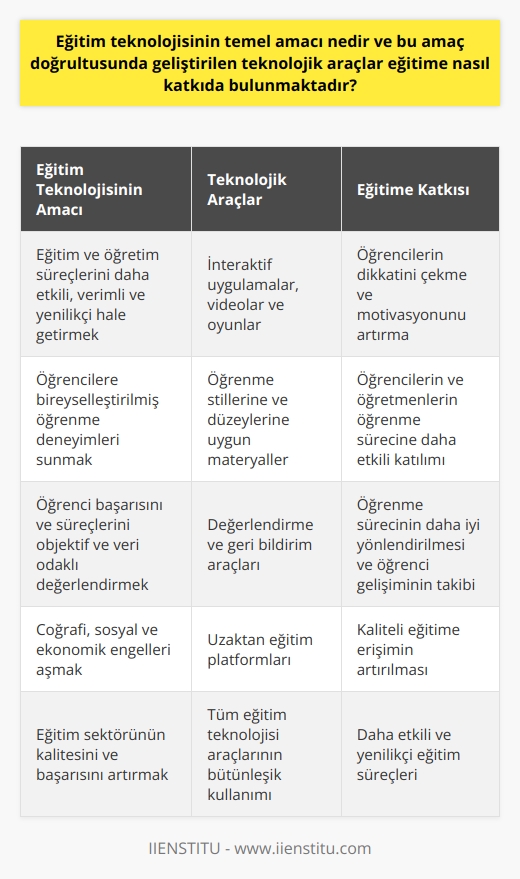
Geleceğin teknolojisi eğitim alanında hangi tür değişiklikler ve dönüşümleri beraberinde getirecektir?
Geleceğin Teknolojisi ve Eğitim Alanındaki Dönüşüm
Geleceğin eğitim teknolojisi, bilgi ve iletişim çağında yenilikçi uygulamalar ve altyapılar getirecek, hızla değişen teknolojilere uyum sağlayabilen toplumlar büyük kazanımlar elde edecektir. Ülkemizde, ilk olarak 1960'ta tanıştığımız bilgisayarlar ve 1993'ten itibaren internetin kullanımı, eğitim alanında büyük dönüşümler yaşanmasını sağlamış olsa da, kaliteli eğitim için önümüzde hala birçok adım bulunmaktadır.
Geleneksel Eğitimciliğin Teknolojiyle Buluşması
Eğitim sistemimizde kullanılan materyaller, kara tahtalar ve tepegözler yerini akıllı tahtalara ve bilgisayarlara bırakmış olsa bile, eğitimcilerimizin geleneksel çözüm arayışları yüzünden teknolojinin imkanlarını tam olarak kullanamamaktadır. Bu nedenle, teknoloji ve eğitimciliğin birleşimi, daha etkin ve kaliteli bir eğitim sürecinin başlıca faktörlerinden biri olacaktır.
Üniversiteler ve Sanal Sınıflar
Üniversiteler ve eğitim kurumlarının sağladığı eğitimler, yeni nesillerin birden fazla uzmanlık alanına sahip olmasını teşvik etmektedir. Gelecekte, sanal sınıflar ve hologram görüntüleri ile eşzamanlı olarak birden fazla derse katılabilme imkanı sunulması beklenmektedir. Ayrıca, sanal bellekler sayesinde hafıza sorunları ortadan kalkacak ve bilgiye hızlı ve kolay bir şekilde ulaşabileceğiz.
Eğitimcilerin Rolü ve Teknolojik Gelişmelere Yaklaşım
Teknolojide yaşanan hızlı gelişmeler ve eğitim işlevlerinin iyileştirilmesine yönelik yardımlar sunulsa da, kaliteli eğitimin temelinde öncelikle kaliteli bireyler yetiştirmek yatmalıdır. Eğitimcilerin, bilgiye ulaşmak, bilgiyi aktarmak ve doğru kullanmak hususunda hassas bir şekilde çalışması beklenmektedir. Aynı zamanda, teknolojik gelişmelere yaklaşım tarzımız ve doğru analiz yapma yeteneğimiz, eğitim anlayışımızı kökünden değiştirecek mi, yoksa kaliteli eğitimin olmazsa olmazı mı olacak sorusunun cevabını belirleyecektir.
Sonuç olarak, geleceğin eğitim teknolojisi ile eğitim alanında çok büyük dönüşümler yaşanacak, ancak bu dönüşümlerin kaliteli eğitime hizmet edecek şekilde gerçekleştirilmesi için eğitimcilerin ve toplumun doğru bir şekilde adapte olması gerekmektedir. Bu noktada, teknoloji ve eğitim alanında işbirliği yaparak somut adımlar atılmalı ve geleceğin eğitim teknolojisine uygun hale getirilmeliyiz.
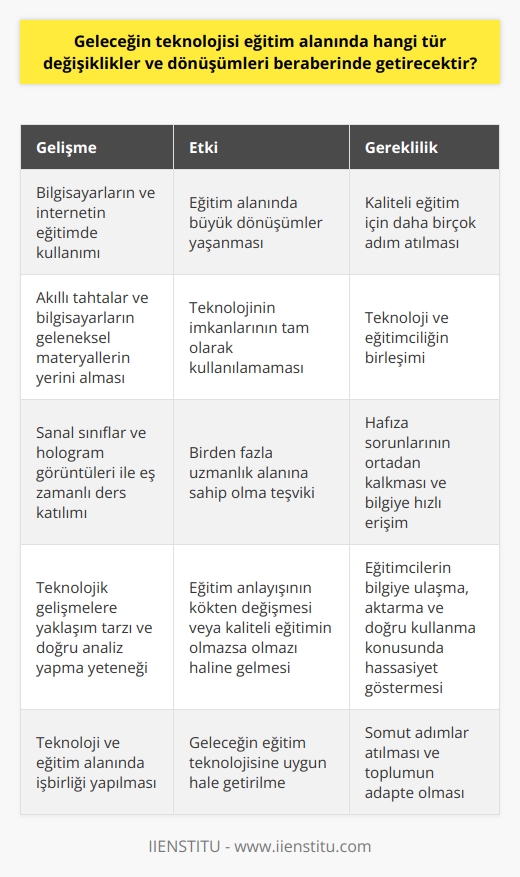
Eğitim Teknolojisi neleri kapsar ve bu teknolojilerin öğrenciler üzerindeki olumlu ve olumsuz etkileri nelerdir?
Eğitim Teknolojisi Kapsamı ve Öğrenci Üzerindeki Etkileri
Eğitim teknolojisi, günümüzde hızla gelişen ve eğitim sektörünün önemli bir parçası haline gelen bir kavramdır. Eğitim teknolojisi, öğretim süreçlerine bilgisayar ve internet teknolojisi gibi araçların entegrasyonu, akıllı tahtalar ve eğitim platformları gibi teknolojik materyallerin kullanımını içerir. Bu kavram, öğrencilerin öğrenme süreçlerine önemli katkılar sağlarken, aynı zamanda olumlu ve olumsuz etkileri de mevcuttur.
Olumlu Etkiler
Bilgiye Hızlı ve Kolay Erişim: İnternet ve eğitim platformları sayesinde öğrenciler, ihtiyaç duydukları bilgilere hızlı ve kolay bir şekilde ulaşabilmektedir. Bu durum, öğrenme süreçlerinin daha verimli ve etkili olmasına katkı sağlar.
Esnek Öğrenme Ortamı: Teknoloji kullanımı, öğrencilere zaman ve mekan sınırlaması olmaksızın eğitim alabilme imkanı tanır. Böylece öğrenciler, kendi öğrenme hızlarını ve süreçlerini kontrol edebilirler.
Motivasyon Sağlama: Eğitim teknolojileri, öğrencilere daha cazip ve ilgi çekici materyaller sunarak öğrenme motivasyonunu arttırır. Bu durum, öğrencilerin başarı düzeylerini de olumlu yönde etkiler.
Olumsuz Etkiler
Fiziksel ve Göz Sağlığı: Uzun süreler boyunca teknolojik araçlar kullanmak, özellikle çocuklar ve gençler için fiziksel ve göz sağlığına zarar verebilir. Duruş bozuklukları ve göz yorgunluğu gibi şikayetler, teknoloji kullanımının risklerini oluşturur.
Sosyal İlişkilerin Zayıflaması: Öğrencilerin teknolojiye olan bağımlılığı, sosyal ilişkilerin zayıflamasına ve iletişim becerilerinin gelişmemesine yol açabilir. Bu durum, öğrencilerin sosyal beceriler açısından eksiklik yaşamasına sebep olur.
Bilgi Yığınlaşması ve Sorgulama Yetersizliği: Hızlı ve kolay bilgiye erişim imkanı, öğrencilerin doğru bilgiyi seçmekte zorlanmasına ve bilgi yığını içerisinde kaybolmasına sebep olabilir. Ayrıca, kritik düşünme ve sorgulama becerilerinin geliştirilmesi konusunda yetersizlikler yaşanabilir.
Sonuç olarak, eğitim teknolojisi kullanımının öğrenciler üzerinde hem olumlu hem de olumsuz etkileri bulunmaktadır. Bu nedenle, bu teknolojilerin etkin ve bilinçli bir şekilde kullanılması, öğrencilerin sağlıklı ve başarılı bir eğitim süreci geçirmeleri için önem taşımaktadır.
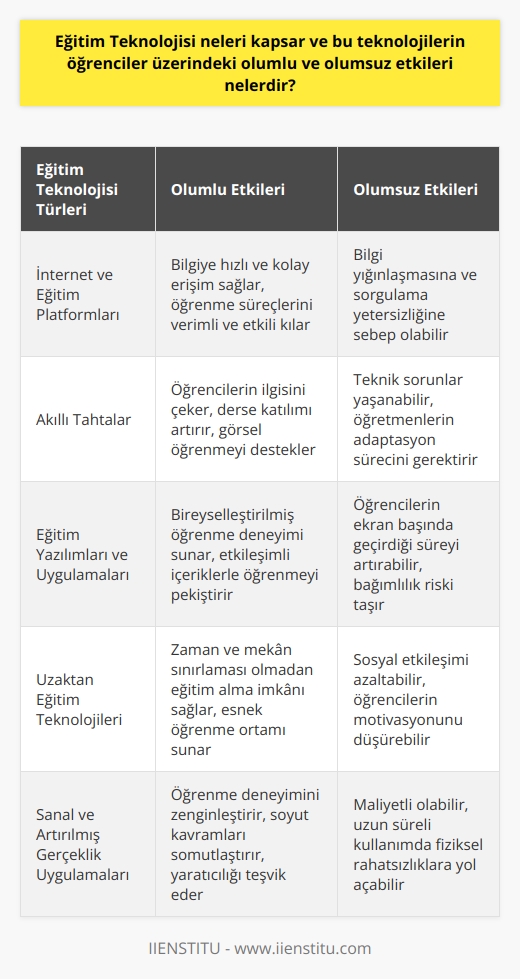
Eğitim için yapılmış en iyi teknolojik gelişme hangi alanda gerçekleşmiştir ve bu gelişme eğitime nasıl katkı sağlamıştır?
Eğitim Teknolojilerindeki Gelişmeler ve Katkıları
Günümüzde en önemli teknolojik gelişmelerden biri eğitim alanında yaşanmaktadır. Bu bağlamda, özellikle bilgisayar ve internet teknolojilerindeki hızlı ilerleme, eğitimde kullanılan yöntem ve materyallerin de değişimine yol açmaktadır. Bu gelişmelerin eğitime sağladığı katkı açısından değerlendirildiğinde, en önemli alanın bilgi erişimi, iletişim ve uzaktan eğitim olduğu görülmektedir.
Bilgi Erişimi ve İletişim Açısından Teknolojik Gelişmeler
21. yüzyılın bilgi çağında, teknoloji kullanımının eğitime katkısı büyüktür. Gelişen internet teknolojileri, bilgiye daha kolay, hızlı ve güvenli ulaşmayı sağlar. Bu sayede, eğitimciler ve öğrenciler, geleneksel yöntemlerle karşılaştırıldığında çok daha fazla bilgiye erişebilir ve birbirleriyle daha etkili bir iletişim kurabilirler. Bu, diğer alanlardaki yeniliklerin eğitime de entegrasyonunu destekler ve kaliteli eğitimin sağlanmasında önemli bir role sahiptir.
Uzaktan Eğitimin Önemi ve Kapsamı
Eğitimde teknolojik gelişmenin bir başka önemli yönü de uzaktan eğitimdir. Ülkemizde, üniversiteler ve eğitim kurumları, eğitim vermek amacıyla uzaktan eğitim sistemlerini kullanmaktadır. Bu durum, özellikle farklı uzmanlık alanlarına sahip yeni nesillerin yetişmesine büyük katkı sağlar. Uzaktan eğitim, öğrencilere ve eğitimcilerin esnek zaman yönetimi ve maliyet tasarrufu sağlamaktadır. Ayrıca, bilgi ve beceri transferi daha hızlı ve kolay gerçekleşir.
Eğitim Anlayışının Dönüşümü ve Gelecek Perspektifi
Teknolojik gelişmeler ve sağlayabileceği yararlar ışığında, geleceğin eğitim teknolojilerinin nasıl bir şekil alacağı önemli bir sorunsaldır. Eğitim sisteminde kullanılan kara tahtalar, tepegözler gibi geleneksel materyaller yerini giderek akıllı tahtalara ve bilgisayarlara bırakmaktadır. Sanal sınıflardaki öğretmen ve öğrenci hologramları gibi hayal edilen yenilikler, teknolojideki hızlı gelişmeler sayesinde önümüzdeki çeyrek yüzyılda gerçekleşebilir. Ancak, teknolojinin getirdiği olanaklardan yararlanabilmek için, eğitimcilerin öncelikle bilgiye ulaşım, aktarım ve doğru kullanımı gibi konular üzerinde durmaları gerekmektedir.
Sonuç olarak, eğitim alanındaki teknolojik gelişmeler, bilgi erişimi, iletişim ve uzaktan eğitim gibi asıl uygulama alanlarında büyük oranda pozitif katkılar sağlar. Ancak, kaliteli ve nitelikli bireyler yetiştirebilmek için eğitimcilerin ve öğrencilerin yeni teknolojilere uyum sağlayarak, doğru tanı ve uygulamaları geliştirmeleri önem teşkil etmektedir. Böylece, geleceğin eğitim teknolojisi kaliteli eğitimin olmazsa olmaz unsurlarından biri haline gelebilir.
